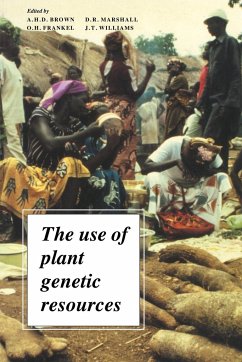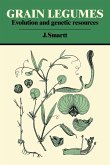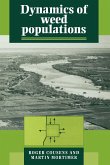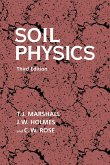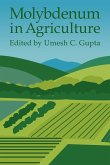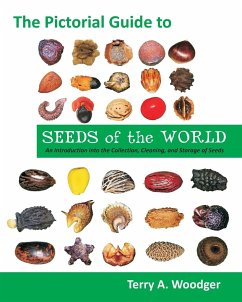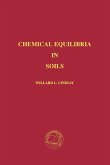A. H. D. Brown / O. H. Frankel / D. R. Marshall / J. T. Williams (eds.)
The Use of Plant Genetic Resou
Herausgeber: Brown, A. H. D.; Marshall, D. R.; Frankel, O. H.
A. H. D. Brown / O. H. Frankel / D. R. Marshall / J. T. Williams (eds.)
The Use of Plant Genetic Resou
Herausgeber: Brown, A. H. D.; Marshall, D. R.; Frankel, O. H.
- Broschiertes Buch
- Merkliste
- Auf die Merkliste
- Bewerten Bewerten
- Teilen
- Produkt teilen
- Produkterinnerung
- Produkterinnerung
This volume stresses the way in which the pool of plant genetic resources provides vital raw material for producing new and improved crops and as source materials for experimental biologists.
Andere Kunden interessierten sich auch für
![Grain Legumes Grain Legumes]() J. SmarttGrain Legumes48,99 €
J. SmarttGrain Legumes48,99 €![Dynamics of Weed Populations Dynamics of Weed Populations]() Roger CousensDynamics of Weed Populations88,99 €
Roger CousensDynamics of Weed Populations88,99 €![Soil Physics Soil Physics]() T. J. MarshallSoil Physics105,99 €
T. J. MarshallSoil Physics105,99 €![Molybdenum in Agriculture Molybdenum in Agriculture]() Umesh C. Gupta (ed.)Molybdenum in Agriculture44,99 €
Umesh C. Gupta (ed.)Molybdenum in Agriculture44,99 €![The Pictorial Guide to Seeds of the World The Pictorial Guide to Seeds of the World]() Terry A. WoodgerThe Pictorial Guide to Seeds of the World44,99 €
Terry A. WoodgerThe Pictorial Guide to Seeds of the World44,99 €![DIY Mobile Solar Power 2020: The Complete Guide To 12 Volt Mobile Solar Power For Rv's, Boats, Vans, And Cars DIY Mobile Solar Power 2020: The Complete Guide To 12 Volt Mobile Solar Power For Rv's, Boats, Vans, And Cars]() Jacob HowellDIY Mobile Solar Power 2020: The Complete Guide To 12 Volt Mobile Solar Power For Rv's, Boats, Vans, And Cars11,99 €
Jacob HowellDIY Mobile Solar Power 2020: The Complete Guide To 12 Volt Mobile Solar Power For Rv's, Boats, Vans, And Cars11,99 €![Chemical Equilibria in Soils Chemical Equilibria in Soils]() Willard Lyman LindsayChemical Equilibria in Soils80,99 €
Willard Lyman LindsayChemical Equilibria in Soils80,99 €-
-
-
This volume stresses the way in which the pool of plant genetic resources provides vital raw material for producing new and improved crops and as source materials for experimental biologists.
Hinweis: Dieser Artikel kann nur an eine deutsche Lieferadresse ausgeliefert werden.
Hinweis: Dieser Artikel kann nur an eine deutsche Lieferadresse ausgeliefert werden.
Produktdetails
- Produktdetails
- Verlag: Cambridge University Press
- Seitenzahl: 396
- Erscheinungstermin: 20. März 2008
- Englisch
- Abmessung: 229mm x 152mm x 23mm
- Gewicht: 641g
- ISBN-13: 9780521368865
- ISBN-10: 0521368863
- Artikelnr.: 23800540
- Herstellerkennzeichnung
- Libri GmbH
- Europaallee 1
- 36244 Bad Hersfeld
- gpsr@libri.de
- Verlag: Cambridge University Press
- Seitenzahl: 396
- Erscheinungstermin: 20. März 2008
- Englisch
- Abmessung: 229mm x 152mm x 23mm
- Gewicht: 641g
- ISBN-13: 9780521368865
- ISBN-10: 0521368863
- Artikelnr.: 23800540
- Herstellerkennzeichnung
- Libri GmbH
- Europaallee 1
- 36244 Bad Hersfeld
- gpsr@libri.de
Preface; Acknowledgements; Part I. Role of Genetic Resource Collections in
Research and Breeding: 1. Germplasm collections and the public plant
breeder K. S. Gill; 2. Germplasm collections and the private plant breeder
J. S. C. Smith and D. N. Duvick; 3. Germplasm collections and the
experimental biologist R. G. Palmer; Part II. Use of Collections: 4.
International use of a sorghum germplasm collection K. E. Prasada Rao, M.
H. Mengesha and V. G. Reddy; 5. Current use of potato collections J. G. Th.
Hermsen; 6. Use of collections in cereal improvement in semi-arid areas J.
P. Srivastava and A. B. Damania; 7. Limitations to the use of germplasm
collections D. R. Marshall; Part III. Size and Structure of Collections: 8.
The case for large collections T. T. Chang; 9. The Case for core
collections A. H. D. Brown; 10. The role of networks of dispersed
collections P. M. Perret; Part IV. Evaluation: 11. Characterisation and
evaluation of okra S. Hamon and D. H. van Sloten; 12. Evaluation of cereals
in Europe G. Fischbeck; 13. Evaluatling the germplasm of groundnut (Arachis
hypogaea) and wild Arachis species at ICRISAT J. P. Moss, V. Ramanatha Rao
and R. W. Gibbons; 14. Practical considerations relevant to effective
evaluation J. T. Williams; 15. Principles and strategies of evaluation O.
H. Frankel; Part V. Wild Relatives of Crops: 16. Collection strategies for
the wild relatives of field crops C. G. D. Cahpman; 17. Wild relatives as
sources of disease resistance J. J. Burdon and A. M. Jarosz; 18. Ecological
and genetic considerations in collecting and using wild relatives G.
Ladizinsky; Part VI. Technological or Scientific Innovations that Affect
the use of Genetic Resources: 19. In vitro conservation and germplasm
utilisation L. A. Withers; 20. Screening for resistance to diseases P. H.
Williams; 21. Restriction fragments as molecular markers for germplasm
evaluation and utilisation R. Bernatsky and S. D. Tanksley; 22. Molecular
biology and genetic resources W. J. Peacock; Index.
Research and Breeding: 1. Germplasm collections and the public plant
breeder K. S. Gill; 2. Germplasm collections and the private plant breeder
J. S. C. Smith and D. N. Duvick; 3. Germplasm collections and the
experimental biologist R. G. Palmer; Part II. Use of Collections: 4.
International use of a sorghum germplasm collection K. E. Prasada Rao, M.
H. Mengesha and V. G. Reddy; 5. Current use of potato collections J. G. Th.
Hermsen; 6. Use of collections in cereal improvement in semi-arid areas J.
P. Srivastava and A. B. Damania; 7. Limitations to the use of germplasm
collections D. R. Marshall; Part III. Size and Structure of Collections: 8.
The case for large collections T. T. Chang; 9. The Case for core
collections A. H. D. Brown; 10. The role of networks of dispersed
collections P. M. Perret; Part IV. Evaluation: 11. Characterisation and
evaluation of okra S. Hamon and D. H. van Sloten; 12. Evaluation of cereals
in Europe G. Fischbeck; 13. Evaluatling the germplasm of groundnut (Arachis
hypogaea) and wild Arachis species at ICRISAT J. P. Moss, V. Ramanatha Rao
and R. W. Gibbons; 14. Practical considerations relevant to effective
evaluation J. T. Williams; 15. Principles and strategies of evaluation O.
H. Frankel; Part V. Wild Relatives of Crops: 16. Collection strategies for
the wild relatives of field crops C. G. D. Cahpman; 17. Wild relatives as
sources of disease resistance J. J. Burdon and A. M. Jarosz; 18. Ecological
and genetic considerations in collecting and using wild relatives G.
Ladizinsky; Part VI. Technological or Scientific Innovations that Affect
the use of Genetic Resources: 19. In vitro conservation and germplasm
utilisation L. A. Withers; 20. Screening for resistance to diseases P. H.
Williams; 21. Restriction fragments as molecular markers for germplasm
evaluation and utilisation R. Bernatsky and S. D. Tanksley; 22. Molecular
biology and genetic resources W. J. Peacock; Index.
Preface; Acknowledgements; Part I. Role of Genetic Resource Collections in
Research and Breeding: 1. Germplasm collections and the public plant
breeder K. S. Gill; 2. Germplasm collections and the private plant breeder
J. S. C. Smith and D. N. Duvick; 3. Germplasm collections and the
experimental biologist R. G. Palmer; Part II. Use of Collections: 4.
International use of a sorghum germplasm collection K. E. Prasada Rao, M.
H. Mengesha and V. G. Reddy; 5. Current use of potato collections J. G. Th.
Hermsen; 6. Use of collections in cereal improvement in semi-arid areas J.
P. Srivastava and A. B. Damania; 7. Limitations to the use of germplasm
collections D. R. Marshall; Part III. Size and Structure of Collections: 8.
The case for large collections T. T. Chang; 9. The Case for core
collections A. H. D. Brown; 10. The role of networks of dispersed
collections P. M. Perret; Part IV. Evaluation: 11. Characterisation and
evaluation of okra S. Hamon and D. H. van Sloten; 12. Evaluation of cereals
in Europe G. Fischbeck; 13. Evaluatling the germplasm of groundnut (Arachis
hypogaea) and wild Arachis species at ICRISAT J. P. Moss, V. Ramanatha Rao
and R. W. Gibbons; 14. Practical considerations relevant to effective
evaluation J. T. Williams; 15. Principles and strategies of evaluation O.
H. Frankel; Part V. Wild Relatives of Crops: 16. Collection strategies for
the wild relatives of field crops C. G. D. Cahpman; 17. Wild relatives as
sources of disease resistance J. J. Burdon and A. M. Jarosz; 18. Ecological
and genetic considerations in collecting and using wild relatives G.
Ladizinsky; Part VI. Technological or Scientific Innovations that Affect
the use of Genetic Resources: 19. In vitro conservation and germplasm
utilisation L. A. Withers; 20. Screening for resistance to diseases P. H.
Williams; 21. Restriction fragments as molecular markers for germplasm
evaluation and utilisation R. Bernatsky and S. D. Tanksley; 22. Molecular
biology and genetic resources W. J. Peacock; Index.
Research and Breeding: 1. Germplasm collections and the public plant
breeder K. S. Gill; 2. Germplasm collections and the private plant breeder
J. S. C. Smith and D. N. Duvick; 3. Germplasm collections and the
experimental biologist R. G. Palmer; Part II. Use of Collections: 4.
International use of a sorghum germplasm collection K. E. Prasada Rao, M.
H. Mengesha and V. G. Reddy; 5. Current use of potato collections J. G. Th.
Hermsen; 6. Use of collections in cereal improvement in semi-arid areas J.
P. Srivastava and A. B. Damania; 7. Limitations to the use of germplasm
collections D. R. Marshall; Part III. Size and Structure of Collections: 8.
The case for large collections T. T. Chang; 9. The Case for core
collections A. H. D. Brown; 10. The role of networks of dispersed
collections P. M. Perret; Part IV. Evaluation: 11. Characterisation and
evaluation of okra S. Hamon and D. H. van Sloten; 12. Evaluation of cereals
in Europe G. Fischbeck; 13. Evaluatling the germplasm of groundnut (Arachis
hypogaea) and wild Arachis species at ICRISAT J. P. Moss, V. Ramanatha Rao
and R. W. Gibbons; 14. Practical considerations relevant to effective
evaluation J. T. Williams; 15. Principles and strategies of evaluation O.
H. Frankel; Part V. Wild Relatives of Crops: 16. Collection strategies for
the wild relatives of field crops C. G. D. Cahpman; 17. Wild relatives as
sources of disease resistance J. J. Burdon and A. M. Jarosz; 18. Ecological
and genetic considerations in collecting and using wild relatives G.
Ladizinsky; Part VI. Technological or Scientific Innovations that Affect
the use of Genetic Resources: 19. In vitro conservation and germplasm
utilisation L. A. Withers; 20. Screening for resistance to diseases P. H.
Williams; 21. Restriction fragments as molecular markers for germplasm
evaluation and utilisation R. Bernatsky and S. D. Tanksley; 22. Molecular
biology and genetic resources W. J. Peacock; Index.

